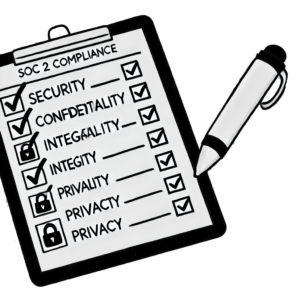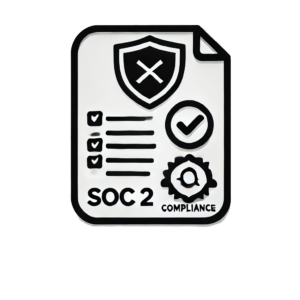Introduction to SOC 2 Compliance

In the realm of cybersecurity, SOC 2 compliance is a crucial framework that focuses on the security, availability, processing integrity, confidentiality, and privacy of customer data. For organizations that store and process sensitive information in the cloud, comprehending SOC 2 is essential for maintaining trust with clients and safeguarding their data. SOC 2 compliance requirements encompass a range of controls and policies that companies must adhere to in order to demonstrate their commitment to data security and privacy.
One key aspect of understanding SOC 2 is grasping the different trust service criteria included in the assessment. These criteria, such as security, availability, confidentiality, processing integrity, and privacy, serve as the foundation for evaluating a company’s compliance with SOC 2 standards. By meeting these requirements, organizations can assure their clients that their data is being handled in a secure and reliable manner.
Furthermore, SOC 2 compliance goes beyond just implementing technical measures; it also necessitates a strong organizational culture of security awareness and risk management. By fostering a security-focused culture and continuously monitoring and improving processes, companies can not only achieve SOC 2 compliance but also enhance their overall cybersecurity posture.
Important Aspects of SOC 2
When it comes to SOC 2 compliance, there are several key aspects that organizations must prioritize to ensure they meet the necessary requirements for data security and privacy. One of the most crucial aspects of SOC 2 is understanding the five trust service criteria – security, availability, processing integrity, confidentiality, and privacy. These criteria form the foundation of SOC 2 compliance and help organizations assess and demonstrate their commitment to protecting customer data.
Additionally, another important aspect of SOC 2 is defining the scope of the audit. Organizations need to clearly identify the systems, people, processes, and third-party vendors that are included in the scope of the audit to ensure comprehensive coverage. This involves mapping out data flows, conducting risk assessments, and implementing controls to mitigate any potential risks.
Furthermore, maintaining documentation and evidence of compliance is essential for SOC 2 success. Organizations must keep detailed records of their policies, procedures, and audit findings to demonstrate ongoing compliance with SOC 2 requirements. Regular monitoring, pentesting, and review of controls are also critical to ensure continuous improvement and adherence to SOC 2 standards.
Key Requirements of SOC 2 Compliance
When it comes to SOC 2 compliance, understanding the Trust Service Principles and Criteria is essential. These principles are a key component of assessing a service organization’s controls and practices. The Trust Service Principles consist of five categories: Security, Availability, Processing Integrity, Confidentiality, and Privacy. Each principle addresses specific areas that are crucial for safeguarding sensitive data and ensuring the reliability of the services provided.
Security is one of the most critical principles, focusing on protecting the organization’s systems and data from unauthorized access. Availability measures the availability of the services and systems for operation and use as agreed upon. Processing Integrity ensures that data processing is complete, valid, accurate, timely, and authorized. Confidentiality addresses the protection of sensitive information from unauthorized disclosure. Privacy focuses on the collection, use, retention, disclosure, and disposal of personal information in compliance with privacy laws and regulations.
By adhering to the Trust Service Principles and Criteria, organizations can demonstrate their commitment to data security and privacy, instilling trust and confidence in their clients and stakeholders. Achieving SOC 2 compliance requires adherence to these principles and undergoing a thorough audit to validate compliance with the established criteria.
Securing Your Systems
As businesses increasingly rely on digital systems to store and process sensitive data, maintaining robust security measures has become paramount. SOC 2 compliance requirements play a crucial role in ensuring that companies adhere to industry best practices and protect their systems from potential threats. Understanding the intricate details of SOC 2 compliance is essential for organizations looking to strengthen their cybersecurity posture and build trust with their customers.
One of the key aspects of SOC 2 compliance is defining the criteria for securing your systems. This includes implementing policies and procedures to safeguard data integrity, confidentiality, and availability. By conducting regular risk assessments and vulnerability scans, organizations can identify potential weaknesses in their systems and address them proactively.
Furthermore, establishing clear access controls and monitoring systems can help detect and prevent unauthorized access to sensitive information. Encryption technologies should also be employed to protect data both at rest and in transit, mitigating the risk of data breaches and unauthorized interception.
In conclusion, prioritizing SOC 2 compliance requirements is crucial for safeguarding your systems and maintaining the trust of your stakeholders. By staying informed about the latest cybersecurity threats and best practices, companies can effectively protect their data assets and ensure operational resilience in the face of evolving cyber risks.
Benefits of Achieving SOC 2 Compliance
Implementing SOC 2 compliance is crucial for businesses that handle sensitive customer data. Understanding the key requirements is essential to ensure your organization meets the necessary standards for data security and privacy. SOC 2 compliance focuses on five trust service criteria: security, availability, processing integrity, confidentiality, and privacy. By adhering to these requirements, your business can demonstrate a commitment to protecting client information and maintaining a secure operational environment.
Meeting SOC 2 compliance requirements involves assessing and documenting your internal controls related to the trust service criteria. This process helps identify potential risks and vulnerabilities, allowing you to implement necessary safeguards to protect against data breaches and unauthorized access. By proactively addressing these requirements, your business can enhance its overall security posture and build trust with customers, partners, and stakeholders.
Stay updated on the latest SOC 2 compliance guidelines and best practices to ensure your business remains compliant with evolving cybersecurity standards. Investing in SOC 2 compliance not only safeguards your business against potential threats but also showcases your commitment to data protection and information security, setting you apart as a trusted and reliable partner in today’s digital landscape.
For Your Clients
Understanding SOC 2 compliance requirements is crucial for businesses looking to demonstrate their commitment to data security and privacy to their clients. SOC 2 compliance is a framework designed to ensure that service providers securely manage data and protect the interests of their clients. By meeting SOC 2 compliance requirements, businesses can enhance their credibility and build trust with their clients, assuring them that their data is handled in a secure manner.
There are five key trust service criteria that companies must meet to achieve SOC 2 compliance: security, availability, processing integrity, confidentiality, and privacy. These criteria cover various aspects of data security and the protection of customer information. By following these requirements, businesses can instill confidence in their clients that their sensitive data is being handled safely and securely.
By educating your clients on the importance of SOC 2 compliance and the measures your business has taken to meet these requirements, you can strengthen your relationships and differentiate yourself as a trustworthy and reliable service provider in the eyes of your clients.

Steps to Prepare for SOC 2 Audit
Understanding the Scope
When it comes to SOC 2 compliance, understanding the scope is essential to ensuring your organization meets all necessary requirements. The scope refers to the specific systems, processes, and controls that are included in the SOC 2 audit. It is crucial to clearly define and document the scope of the audit to provide a clear roadmap for compliance.
One of the key aspects of understanding the scope of SOC 2 compliance is identifying the systems and processes that are relevant to the security, availability, processing integrity, confidentiality, and privacy of customer data. This includes not only your internal systems but also any third-party vendors or service providers that have access to this data.
By thoroughly understanding the scope of the audit, your organization can ensure that all necessary controls are in place to protect sensitive information and demonstrate compliance with SOC 2 requirements. It also helps in identifying any potential gaps or areas for improvement in your security posture, allowing you to proactively address them before the audit.
Planning and Preparing for The Audit
When it comes to SOC 2 compliance requirements, one of the crucial steps is planning and preparing for the audit. This stage is essential for ensuring that your organization meets the necessary standards and is ready to undergo the rigorous audit process. To begin, it is vital to thoroughly understand the scope of the audit and what specific criteria need to be met. This involves conducting a comprehensive assessment of your systems, processes, and controls to identify any potential gaps or weaknesses that need to be addressed.
Additionally, developing a detailed audit plan that outlines the key objectives, timeline, and responsibilities is key to a successful audit. This plan should include tasks such as conducting risk assessments, documenting policies and procedures, and implementing necessary security measures to ensure compliance. It is also important to allocate resources effectively and involve key stakeholders from various departments to ensure a collaborative approach to the audit process.
By properly planning and preparing for the audit, your organization can demonstrate a strong commitment to SOC 2 compliance and position itself for a successful audit outcome.
Implementing SOC 2 Compliance As a Long-Term Strategy
In the realm of SOC 2 compliance requirements, ensuring periodic compliance is a crucial component that organizations must prioritize to maintain data security standards. Periodic compliance involves regularly assessing and validating security controls to ensure they adhere to the established SOC 2 criteria.
By conducting regular audits and assessments, businesses can identify vulnerabilities, address non-compliance issues, and continuously enhance their security posture. This proactive approach not only helps in meeting SOC 2 compliance requirements but also strengthens overall cybersecurity resilience against evolving threats. Implementing a robust compliance monitoring program with scheduled reviews and updates is essential for demonstrating ongoing commitment to data protection and maintaining the trust of customers and stakeholders.
Stay ahead of the curve by prioritizing continual compliance efforts to safeguard sensitive information and mitigate risks effectively.
Continuous Improvement for Security
In the realm of SOC 2 compliance, staying up-to-date with the ever-evolving security landscape is crucial. Continuous improvement for security measures is not only recommended but necessary to meet the stringent SOC 2 compliance requirements. By consistently reviewing and enhancing security protocols, organizations can better protect their data and systems from potential threats and vulnerabilities.
Regularly assessing and reassessing security controls, conducting thorough risk assessments, and implementing necessary updates are all part of the ongoing process of ensuring SOC 2 compliance. This continuous improvement mindset not only helps organizations stay compliant but also strengthens their overall cybersecurity posture, building trust with customers and partners who rely on the security of their systems and data.
